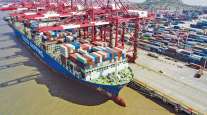October Truck Orders Boost OEMs
This story appears in the Nov. 12 print edition of Transport Topics.
Truck manufacturers received 23,200 new Class 8 orders in October, the highest monthly total since January, despite truck buyers’ ongoing concerns about the economy and the looming “fiscal cliff,” according to ACT Research.
Last month’s healthy order intake was still 17.2% below the level of a year ago but was 45.9% above September’s total, indicating that the swell of new orders that typically accompanies the start of the fourth quarter materialized as usual, said ACT Vice President Steve Tam.
Tam said this is the time when many large fleets are planning their equipment purchases for the coming year, and their decision to place new truck orders was “a vote of confidence that things are going to sustain well enough that they can go ahead” and buy new vehicles.
At Daimler Trucks North America, Class 8 orders jumped 65% in October from the previous month, “outpacing even the impressive increase in overall industry orders,” said David Hames, general manager of marketing and strategy at DTNA.
“We are still hearing a lot of uncertainty regarding the economy, but our customers still have businesses to run and are placing orders for equipment with proven technology that will decrease their overall cost of operations,” Hames said.
The upturn in order activity “signals that the market still has the need to replace the older, inefficient vehicles that are on the road,” he said.
While larger fleets are looking ahead to 2013 for the most part, small- and medium-sized carriers are placing late-year orders to take advantage of the accelerated federal depreciation tax break, said Robert Woodall, assistant general manager of sales and marketing at Peterbilt Motors Co.
“The smaller to mid-sized fleets are the ones that have a different buying pattern, and they’re not as model-year sensitive, typically, so we’re seeing those guys order right here towards the end of the year in the fourth quarter to take advantage of the tax incentives in place,” Woodall said.
Nevertheless, some fleets are still sitting back and waiting for clarity out of Washington, he said.
“There’s been such a stir created over the fiscal cliff that people want to know what’s going to happen with it before they make additional investments,” Woodall said. “Their trucks are old. They need to replace them, but they’re willing to wait three or four more months to see how things shake out.”
The term “fiscal cliff” refers to a series of tax increases and federal spending cuts that Congress set in budget legislation last year that will go into effect at the end of 2012 unless it is able to come up with a new plan to trim federal deficits and set budget priorities.
ACT’s Tam said he was “pleasantly surprised” by the strength of October’s order intake, but added that it may be tough for the industry to top that number in November.
“It may make the rest of the year more challenging,” he said. “We typically see sequential improvement in both November and December, and I’m guessing that we won’t see that, at least from this 23,200 number.”
Despite the strong month-to-month increase in October, net orders declined on a year-over-year basis for the 10th straight month, ACT said.
For the year to date, truck buyers have placed 187,844 new orders through October, down from 254,690 in the same period of 2011, according to ACT’s figures.
Tam attributed the year-over-year declines to “a very good year” in 2011, when production was up almost 66% over 2010.
Tam said manufacturers’ backlogs declined to about 67,000 orders at the end of September, from about 71,000 in August, as they built trucks at a faster rate than they received orders, “which has been the theme throughout the year.”
However, that trend may have reversed because of the strength of new orders in October, he said. Although backlog data for October was not yet available, Tam said backlogs probably held steady or grew during the month.
Manufacturers have trimmed production this year as their build rates exceeded new order intake, but Tam predicted that additional cuts probably won’t be necessary.
“I’m not expecting much in the way of future cuts as long as things continue to progress the way forecasts are laid out right now,” he said. “I think they’ve gotten to where they need to be.”
Woodall said Peterbilt has adjusted its build rates during the course of the year to match order activity, but said the company is “pretty much in alignment with where we need to be right now.”
“Obviously, we’re anxious to see some increased order activity and get production levels back to where they were and beyond,” he said.
Randy Downs, sales manager at Navistar dealer Carolina International Trucks Inc., Columbia, S.C., said order intake stalled in late summer, in part because Navistar’s announced switch to engines with selective catalytic reduction technology caused some customers to pause.
Now that Navistar is offering customers two SCR engine choices with “proven technologies,” Downs expects customer orders to bounce back.
“We’re marching again in the right direction, and we’ve got a strategy that’s proven in the marketplace,” he said. “I think it’s just a matter of time before we start picking back up and gaining back some of the customers we’ve lost.”



